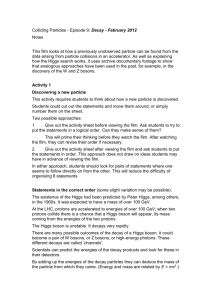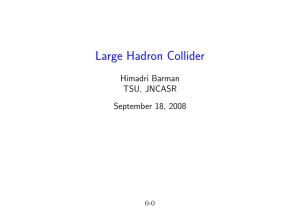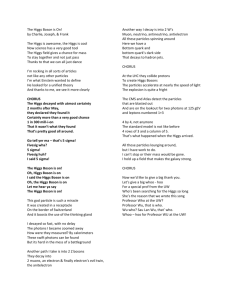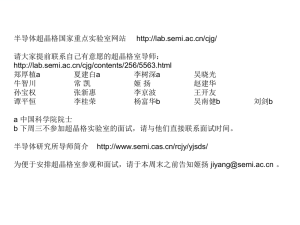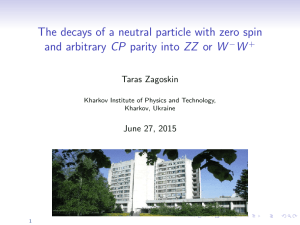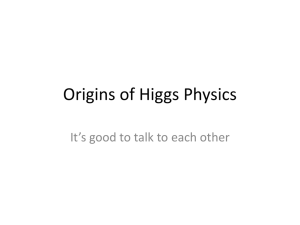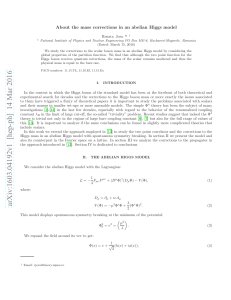Decays of a spin-zero neutral particle with arbitrary CP parity into
advertisement
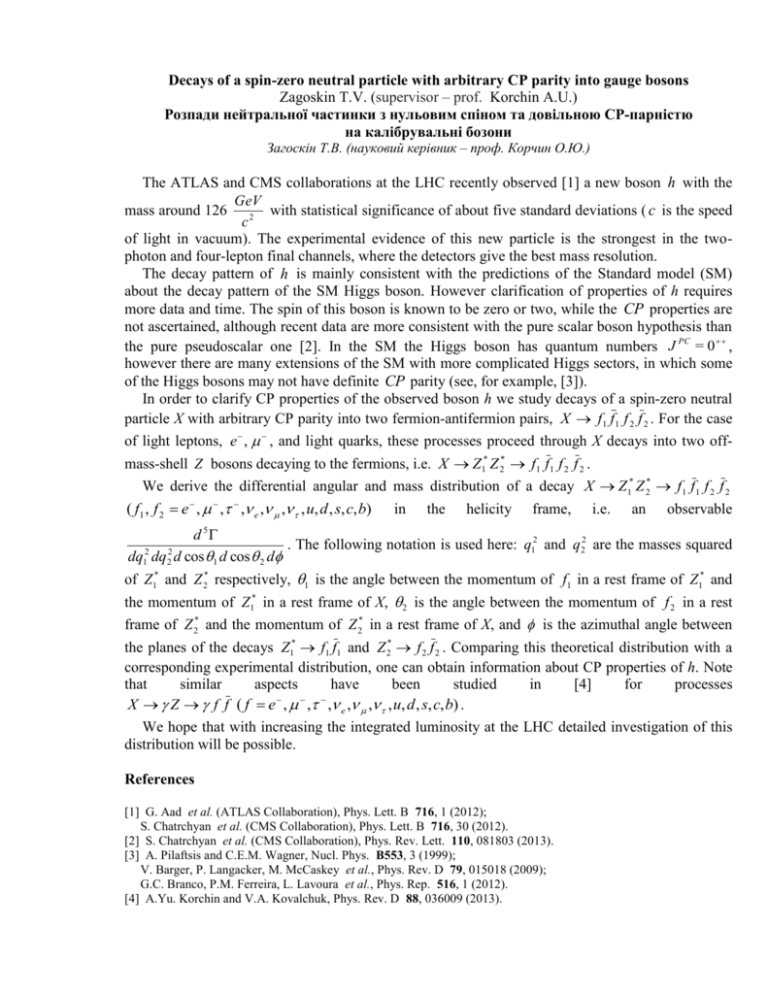
Decays of a spin-zero neutral particle with arbitrary CP parity into gauge bosons Zagoskin T.V. (supervisor – prof. Korchin A.U.) Розпади нейтральної частинки з нульовим спіном та довільною CP-парністю на калібрувальні бозони Загоскін Т.В. (науковий керівник – проф. Корчин О.Ю.) The ATLAS and CMS collaborations at the LHC recently observed [1] a new boson h with the GeV mass around 126 2 with statistical significance of about five standard deviations ( c is the speed c of light in vacuum). The experimental evidence of this new particle is the strongest in the twophoton and four-lepton final channels, where the detectors give the best mass resolution. The decay pattern of h is mainly consistent with the predictions of the Standard model (SM) about the decay pattern of the SM Higgs boson. However clarification of properties of h requires more data and time. The spin of this boson is known to be zero or two, while the CP properties are not ascertained, although recent data are more consistent with the pure scalar boson hypothesis than the pure pseudoscalar one [2]. In the SM the Higgs boson has quantum numbers J PC = 0 , however there are many extensions of the SM with more complicated Higgs sectors, in which some of the Higgs bosons may not have definite CP parity (see, for example, [3]). In order to clarify CP properties of the observed boson h we study decays of a spin-zero neutral particle X with arbitrary CP parity into two fermion-antifermion pairs, X f1 f1 f 2 f 2 . For the case of light leptons, e , , and light quarks, these processes proceed through X decays into two offmass-shell Z bosons decaying to the fermions, i.e. X Z1* Z 2* f1 f1 f 2 f 2 . We derive the differential angular and mass distribution of a decay X Z1* Z 2* f1 f1 f 2 f 2 ( f1 , f 2 e , , , e , , , u, d , s, c, b) in the helicity frame, i.e. an observable d 5 . The following notation is used here: q12 and q 22 are the masses squared dq12 dq 22 d cos 1 d cos 2 d of Z1* and Z 2* respectively, 1 is the angle between the momentum of f1 in a rest frame of Z1* and the momentum of Z1* in a rest frame of X, 2 is the angle between the momentum of f 2 in a rest frame of Z 2* and the momentum of Z 2* in a rest frame of X, and is the azimuthal angle between the planes of the decays Z1* f1 f1 and Z 2* f 2 f 2 . Comparing this theoretical distribution with a corresponding experimental distribution, one can obtain information about CP properties of h. Note that similar aspects have been studied in [4] for processes X Z f f ( f e , , , e , , , u, d , s, c, b) . We hope that with increasing the integrated luminosity at the LHC detailed investigation of this distribution will be possible. References [1] G. Aad et al. (ATLAS Collaboration), Phys. Lett. B 716, 1 (2012); S. Chatrchyan et al. (CMS Collaboration), Phys. Lett. B 716, 30 (2012). [2] S. Chatrchyan et al. (CMS Collaboration), Phys. Rev. Lett. 110, 081803 (2013). [3] A. Pilaftsis and C.E.M. Wagner, Nucl. Phys. B553, 3 (1999); V. Barger, P. Langacker, M. McCaskey et al., Phys. Rev. D 79, 015018 (2009); G.C. Branco, P.M. Ferreira, L. Lavoura et al., Phys. Rep. 516, 1 (2012). [4] A.Yu. Korchin and V.A. Kovalchuk, Phys. Rev. D 88, 036009 (2013).

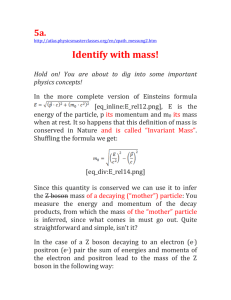

![H = (ni 1)+ (0 µ)ni]](http://s2.studylib.net/store/data/018202045_1-4ea8636c635dd0c1a710519f90b83643-300x300.png)
